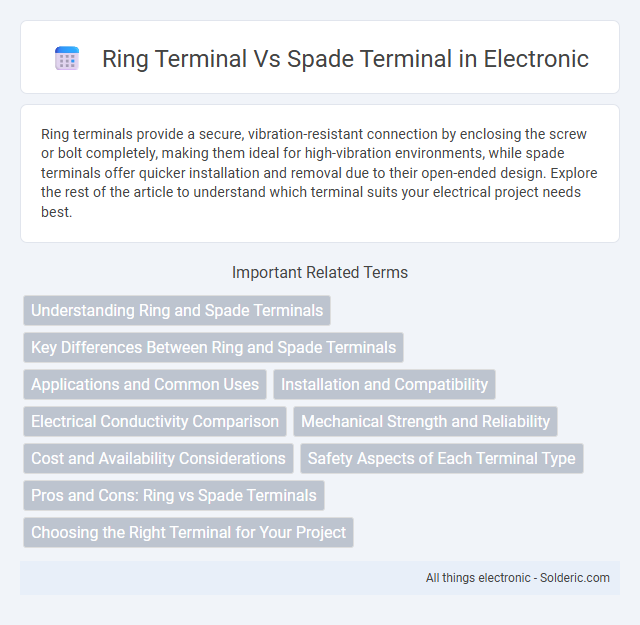Ring terminals provide a secure, vibration-resistant connection by enclosing the screw or bolt completely, making them ideal for high-vibration environments, while spade terminals offer quicker installation and removal due to their open-ended design. Explore the rest of the article to understand which terminal suits your electrical project needs best.
Comparison Table
| Feature | Ring Terminal | Spade Terminal |
|---|---|---|
| Connection Type | Complete ring for secure 360deg connection | Fork-shaped for quick attachment/removal |
| Installation | Requires bolt or screw through ring | Slides under screw/bolt without removal |
| Security | High; resistant to loosening and vibration | Moderate; easier to accidentally disconnect |
| Use Case | Permanent or long-term connections | Temporary or frequent connect/disconnect |
| Application | Automotive, industrial, electrical panels | Control panels, automotive, home wiring |
| Cost | Generally higher due to secure design | Typically lower cost |
| Safety | Safer due to reduced risk of accidental disconnection | Less safe if not properly secured |
Understanding Ring and Spade Terminals
Ring terminals provide a secure electrical connection by fitting over a screw or stud and are ideal for high-vibration environments due to their strong mechanical hold. Spade terminals, also known as fork terminals, allow for quick and easy installation or removal without completely removing the screw, making them suitable for applications requiring frequent maintenance. Both terminals serve to connect wires to devices or bus bars, with material options including copper and insulated versions to enhance conductivity and safety.
Key Differences Between Ring and Spade Terminals
Ring terminals provide a secure connection by completely encircling a screw or stud, preventing accidental disconnection, while spade terminals allow for quick attachment and removal due to their open-ended design. Ring terminals are preferred in applications requiring high vibration resistance and reliability, whereas spade terminals are ideal for situations where rapid maintenance or replacement is necessary. Your choice depends on the balance between connection security and ease of installation in your electrical project.
Applications and Common Uses
Ring terminals are primarily used in automotive, industrial, and marine applications where secure, vibration-resistant connections are essential for grounding and power distribution. Spade terminals are favored in electrical panel wiring and household appliances for their ease of installation and removal, allowing quick disconnects without compromising connection integrity. Both terminals support efficient electrical circuit management but differ in securing methods tailored to specific operational environments.
Installation and Compatibility
Ring terminals ensure secure installation by completely encircling the bolt or stud, preventing accidental disconnection, and are compatible with applications requiring reliable, vibration-resistant connections. Spade terminals offer easier installation and removal due to their open-ended design, making them suitable for quick repairs or frequent disconnections in automotive, marine, and industrial wiring systems. Both terminal types come in various sizes and materials to match different wire gauges and environmental conditions, providing versatile compatibility across electrical projects.
Electrical Conductivity Comparison
Ring terminals provide a more secure and reliable electrical connection than spade terminals, reducing resistance and improving conductivity. The continuous metal ring encircling the screw ensures consistent contact pressure, which minimizes voltage drop and potential signal loss. When optimizing your electrical systems, choosing ring terminals enhances conductivity and overall circuit performance.
Mechanical Strength and Reliability
Ring terminals provide superior mechanical strength and reliability due to their closed-loop design, which ensures a secure connection that resists loosening and vibration-induced failures. Spade terminals offer easier installation and removal but at the cost of reduced holding power, making them less reliable in high-vibration environments. Your choice should consider the mechanical stresses of the application to ensure long-term connection integrity.
Cost and Availability Considerations
Ring terminals generally offer slightly higher costs due to their secure fastening design, while spade terminals tend to be less expensive and easier to install in tight spaces. Both types are widely available from most electrical suppliers, but the choice depends on your project's specific budget constraints and accessibility needs. Understanding these factors ensures efficient selection without compromising electrical reliability.
Safety Aspects of Each Terminal Type
Ring terminals provide a more secure and reliable connection by completely encircling the screw or stud, reducing the risk of accidental disconnection or loosening under vibration. Spade terminals allow quicker installation and removal, but their open-ended design may increase the chance of disconnection or electrical shorts if not properly secured or insulated. Properly crimped and insulated ring terminals enhance safety in high-vibration environments, while spade terminals require diligent maintenance to minimize safety risks.
Pros and Cons: Ring vs Spade Terminals
Ring terminals provide a secure and vibration-resistant connection, minimizing the risk of accidental disconnection, which is ideal for automotive and industrial applications; however, they require complete removal of the screw or bolt for installation, increasing assembly time. Spade terminals allow for quick attachment and removal without fully removing the fastener, offering convenience in maintenance and troubleshooting, but they can be less secure in high-vibration environments and may risk partial disconnection. Choosing between ring and spade terminals depends on the balance between connection security and ease of installation specific to the application requirements.
Choosing the Right Terminal for Your Project
Selecting the right terminal depends on the application's mechanical strength and ease of maintenance requirements. Ring terminals offer superior security with their closed-loop design, ensuring a reliable connection resistant to vibration, ideal for high-vibration environments like automotive or industrial machinery. Spade terminals provide quicker installation and removal, making them suitable for projects that require frequent disconnections or adjustments, such as home wiring or electronics prototyping.
Ring terminal vs Spade terminal Infographic

 solderic.com
solderic.com